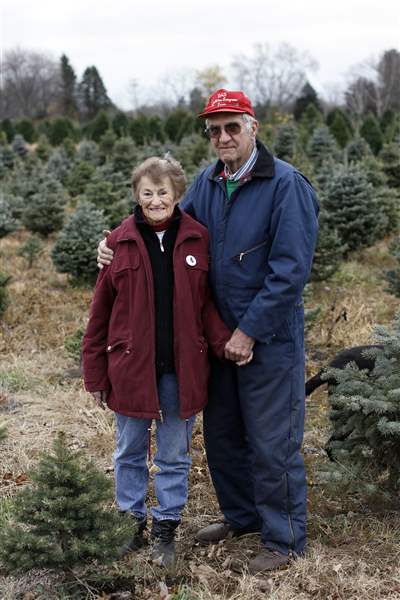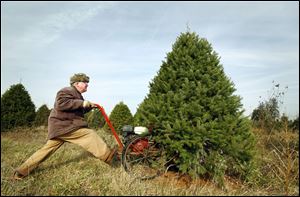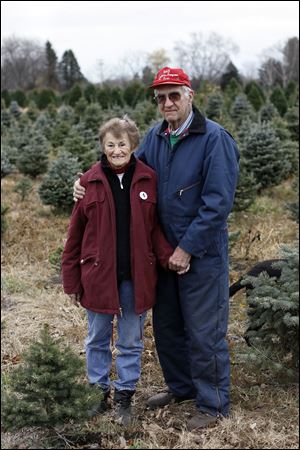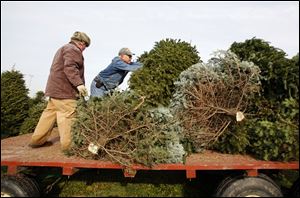
Christmas spirit grows
Choose-and-cut farms live the business
1/24/2013
Peg and Wilbur Matthes at their evergreen tree farm in Ida, Mich.
THE BLADE/ZACK CONKLE
Buy This Image

Gordon Rhoades fells a ten foot tall douglas fir tree at his Rhoades Christmas Tree Farm in Whitehouse.
It’s not shopping, decorating, or entertaining that keep some local people occupied from dawn to dusk this time of year
For evergreen tree farmers, the harvest means long hours and physical work outside in the elements. There are trees to cut, shake, wrap, and load; wreaths and roping to make; holes to dig or fill; signs to put up; temporary staff, perhaps even Santa, to hire. And all the usual business chores such as filling orders, handling correspondence, and managing cash flow.
Since planting 12- to 18-inch seedlings years ago, they've pruned the trees to give them shape, checked and treated for bugs and diseases, fertilized, mowed, and weeded. All comes to fruition now.
“We live the business,” says Wilbur Matthes, owner of Matthes Evergreen Farm in Ida, Mich.
Adds Peg Matthes, his spouse of 63 years, “There’s so much satisfaction in seeing people enjoy what we do.”
At 84 and 86 respectively, they’re the indisputable Grand Poobahs of Christmas Trees in this neck of the woods.
They purchased a fixer-upper farmhouse and barn in 1953, and planted tiny trees in the loamy sand of the knolls that dot their 80 acres in Monroe County. By 1959, they filled relatives' requests for trees, sold to a few coworkers, and set some out by the road with a for-sale sign.
Every year they and their five young children planted more. When the barn burned down almost 30 years ago, they built a new one with plenty of space for making wreaths and holding small livestock. It had space for a snack bar, craft shop, and entertainment. They wanted people to make getting a tree an event, and they don't mind when some tail gate in their parking lots.

Peg and Wilbur Matthes at their evergreen tree farm in Ida, Mich.
"We like choose-and-cut; it's people to people and we like people," says Mrs. Matthes. They sell about 4,000 trees a year.
Robin Rokoski of Toledo made tree buying at the Matthes farm a decades-long tradition.
"It created memories of a lifetime for my children," says Ms. Rokoski, who's partial to blue spruce.
The Matthes' and the handful of other local growers agree that the Fraser fir with a silvery tint to its needles' underside has displaced the Scotch Pine as the most popular tree. Firs are attractive and hold their needles longer than pines, but take longer (eight to 11 years) to reach desirable sizes than do pines (six to eight years). Firs include the Canaan (pronounced kah-NAHN, nearly identical to the Fraser), the White/Concolor with its citrus aroma, and the Douglas.
Although much smaller scale than massive wholesalers, choose-and-cut farmers earn more per tree by foregoing the middleman and selling their own. Nevertheless, the little farms aren't making anybody rich.
Farmers plant in spring and know that beautiful shapes aren't born, they're made, by trimming in the summer with a machete-like blade or long-handled pruners. They keep a watchful eye for needle-blight and spider mites, and dig out stumps and fill the holes with sand.
Rick Johnson was 21 and a laid-off carpenter when he borrowed $600 from his aunt to buy 100 pines, selling them in a Perrysburg lot.
“I think I made more money that year than I have in the last 30,” he says, wryly. The next year, he bought 200.
“Then I asked my father to go into business with me,” says Mr. Johnson, 53, a retired Bowling Green firefighter. They bought land in Michigan and planted 50,000 trees, wholesaling them, which nets the farmer less than when she or he sells trees themselves. “I ended up burning half of them because there was a glut in the market.”
About 15 years ago, he decided to try a choose-and-cut operation on acreage north of Bowling Green.
“I enjoy keeping busy and working outside,” says Mr. Johnson, who also sells firewood. He expects to move about 900 trees this year: 300 at the farm on Dixie Highway; 300 at his lot in Bowling Green, and 300 to tree sellers in Findlay, Columbus, and Dayton.
He's beginning to suspect that pumpkins may be the new Christmas trees, a business seriously whittled down by the popularity of artificial trees. He plants six acres of pumpkins and in the fall, the place turns into the Pumpkin Peddler with hayrides and a craft shop. “I just started messing with them in my own little garden,” he explains getting into gourds. “I think it’s going to surpass the Christmas trees. It’s a good thing artificial pumpkins haven’t taken over.”
Gordon Rhoades planted his first trees in 1980.
"I thought it'd be a little extra income and something different," he says, adding that he figured his children could pitch in and earn money for college.

Gordon Rhoades, left, and field manager David Burkett load trees onto a wagon at Rhoades Christmas Tree Farm in Whitehouse.
He hopes to sell 900 to 1,000 trees this year, both at his Whitehouse farm and to six retailers within 50 miles. He once had 40 acres of trees. "I worked a full-time job too, and all I did was work."
"It takes about eight years to grow a tree. It's a long-term investment. You're going to put a lot of money into the tree before you see anything out of it."
On a recent sunny day, he strode through the rows of trees with a clipboard, a tall measuring stick, and a pencil behind his ear, seeking firs at three different heights to fill a farm market's order for 30 trees. Dave Burkett, his employee, followed with a circular saw on wheels, pushing it into the trunks of trees Mr. Rhoades selected. Seconds after blade met trunk, the tree leaned into the ground, and he marked its sawed bottom with orange, purple, or green chalk to denote its height, and made a corresponding note on his clipboard.
He's excited about a new variety, a Korean fir, that holds its needles extremely well, is very green, and sports a deep silver hue on the needles' underside. It is, however, a slow grower.
Contact Tahree Lane at tlane@theblade.com and 419-724-6075.